Abstract
1. The dose-response relationship for hyperactivity in grouped mice following the injection of morphine sulphate has been established.
2. The activation response can be modified by drugs which affect either catecholamines or indoleamines.
3. The monoamine precursors L-DOPA and 5-hydroxytryptophan potentiate the response.
4. The monoamine synthesis inhibitors α-methyl-p-tyrosine and p-chlorophenylalanine reduce the response.
5. Inhibition of monoamine oxidase activity by pargyline caused a great increase in the response. The simultaneous administration of reserpine resulted in a further potentiation.
6. Reserpine blocked the response whenever it was given alone, either before, with or after the injection of morphine.
7. Blockade of α-adrenoceptors with phentolamine or phenoxybenzamine reduced the response.
8. Blockade of tryptaminergic receptors with methysergide or cinanserin also antagonized the response.
9. The major tranquillizers haloperidol and chlorpromazine reduced the response. Haloperidol was especially effective in this regard.
10. The tricyclic antidepressant drug imipramine potentiated the response.
11. The morphine antagonist nalorphine completely prevented the response.
12. The anticholinergic agent atropine and the antihistaminic drug mepyramine did not affect the response.
13. We conclude that dopamine, noradrenaline and 5-hydroxytryptamine are all involved in the normal activation response of grouped mice to morphine, with dopaminergic mechanisms being of primary importance.
Full text
PDF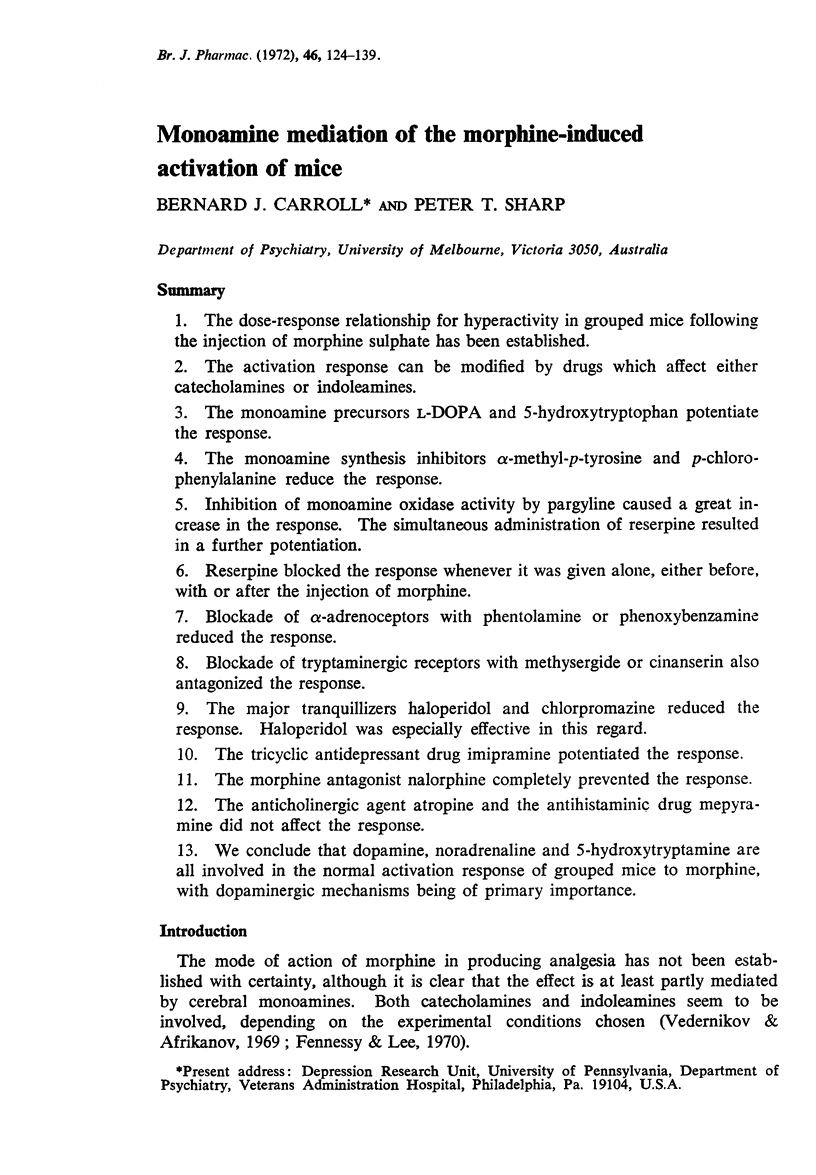

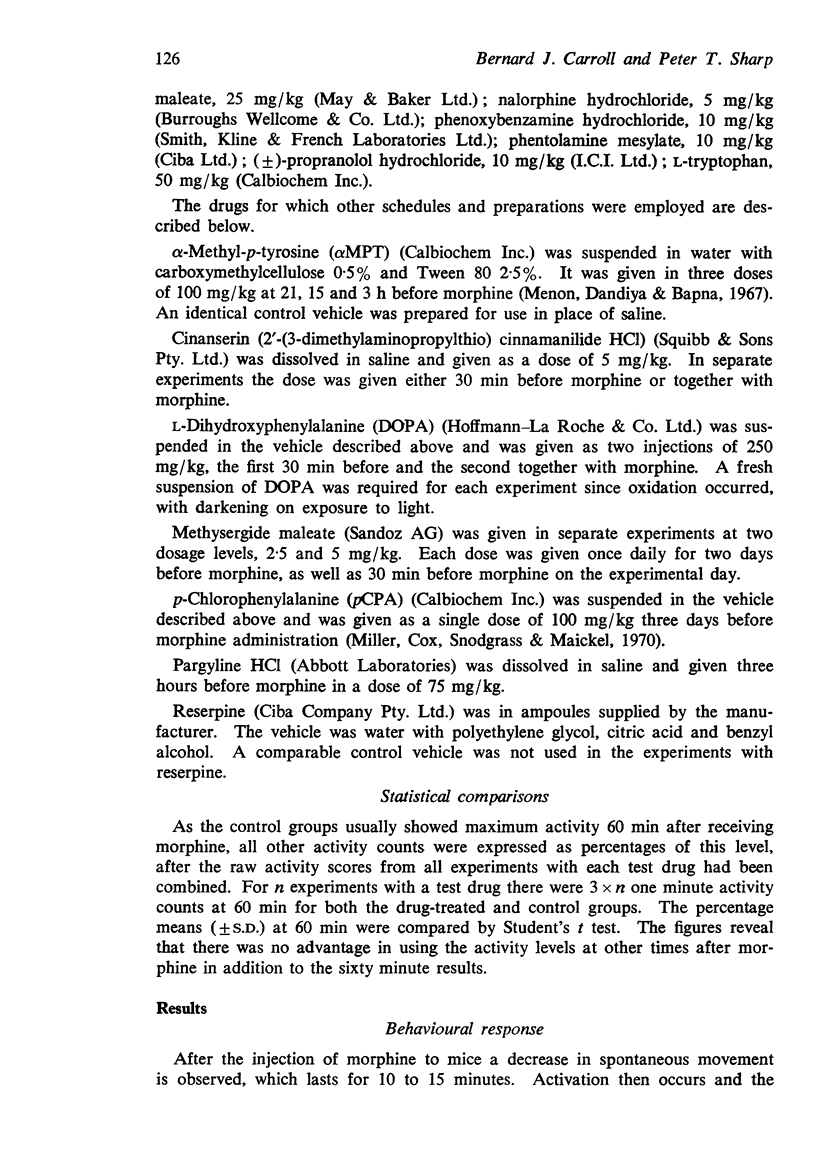

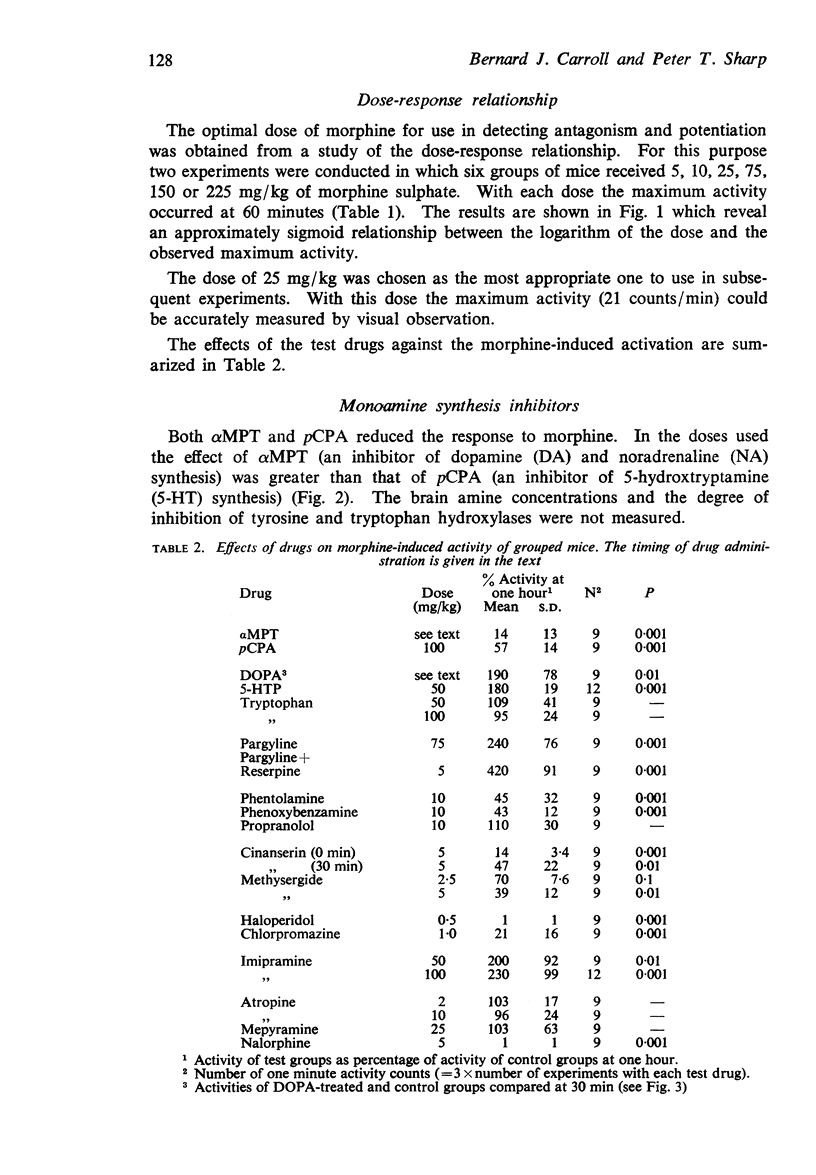
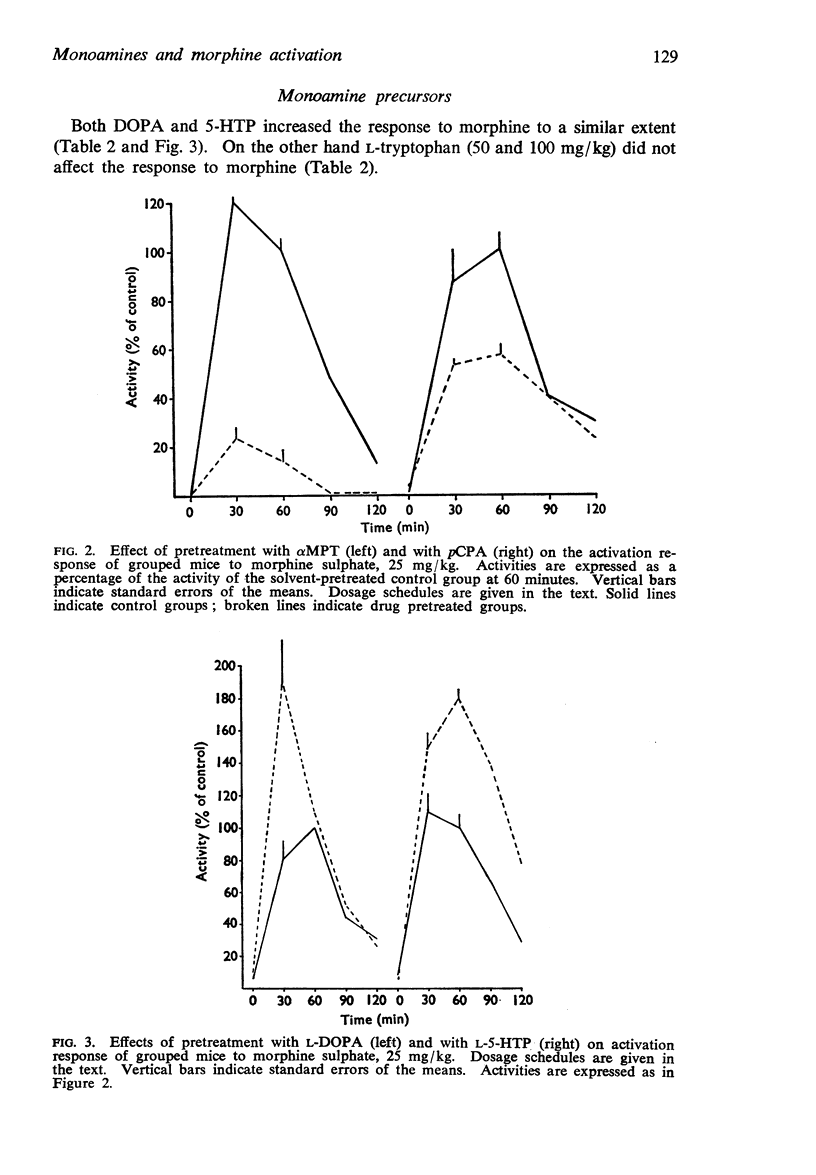
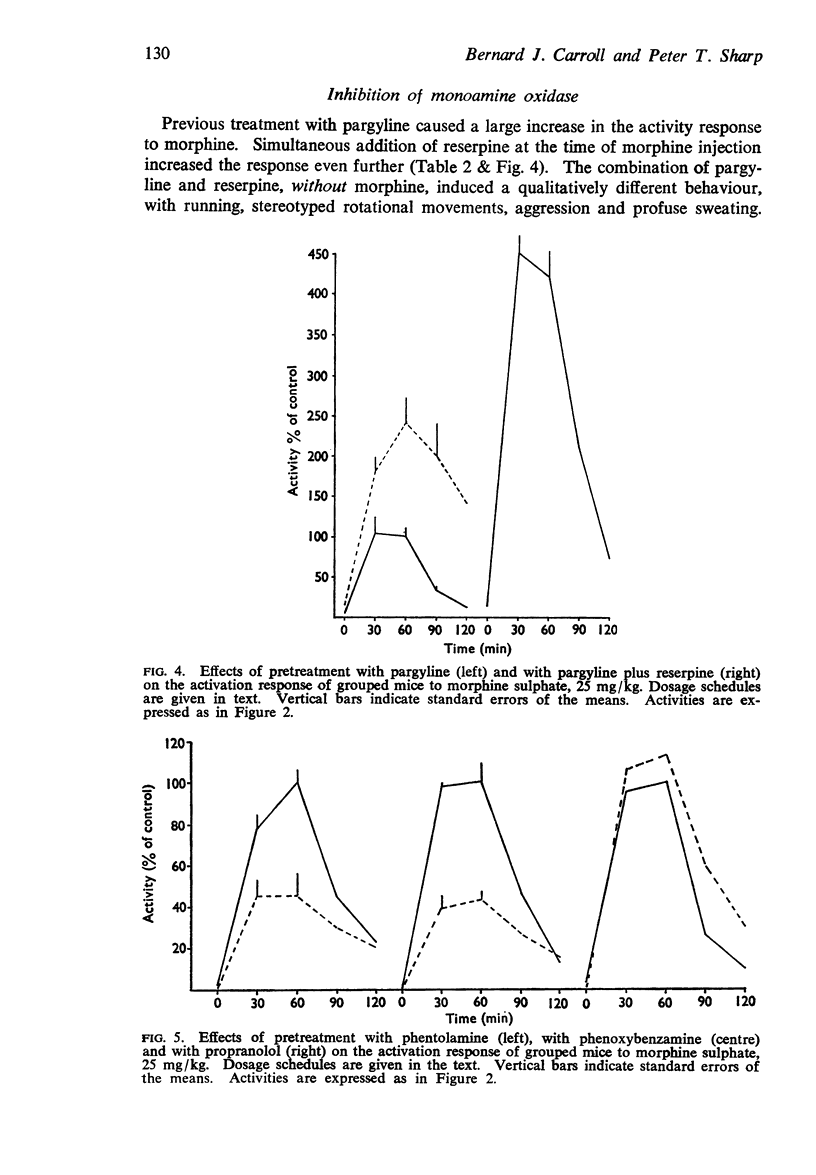
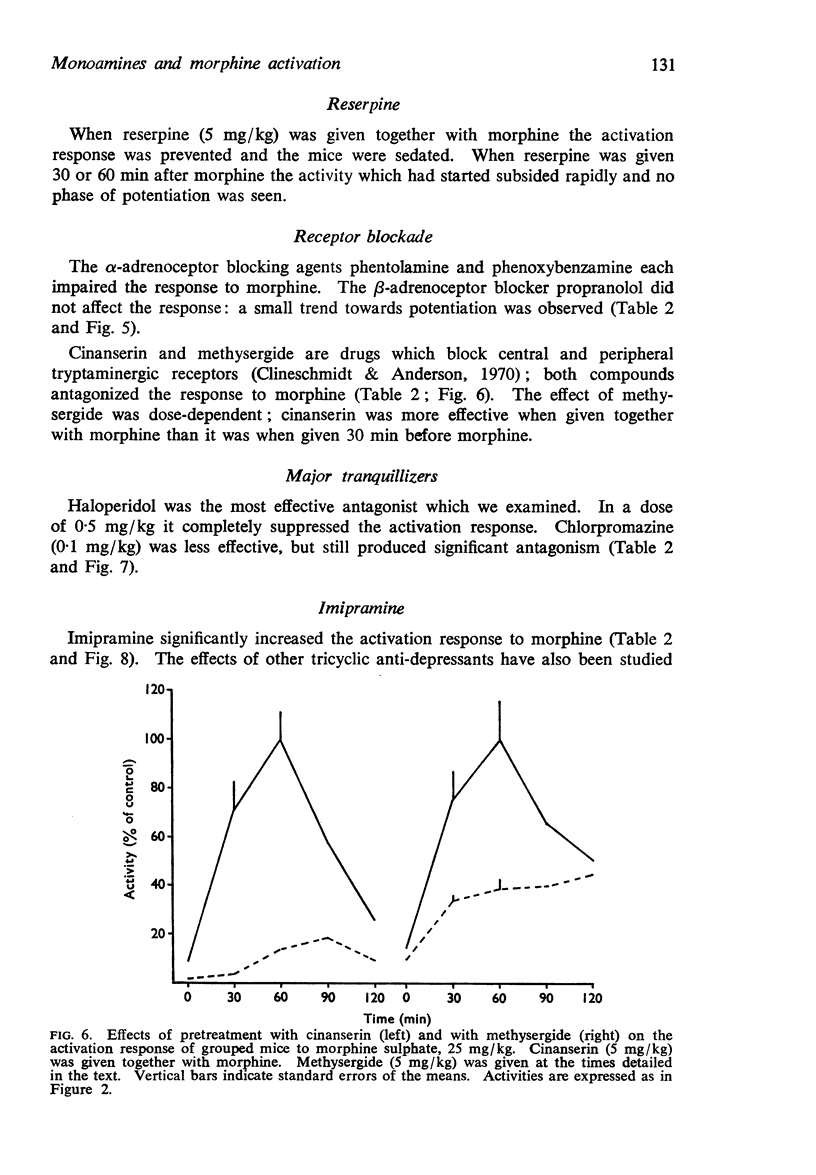

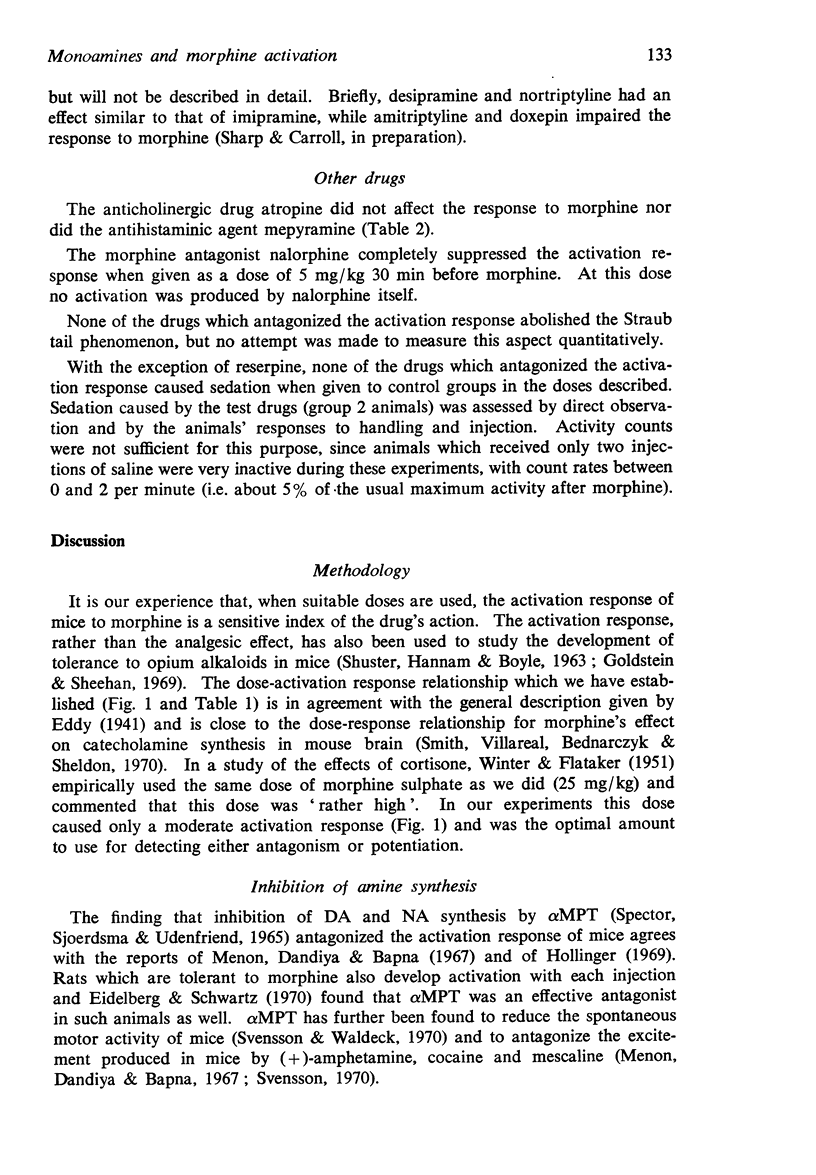

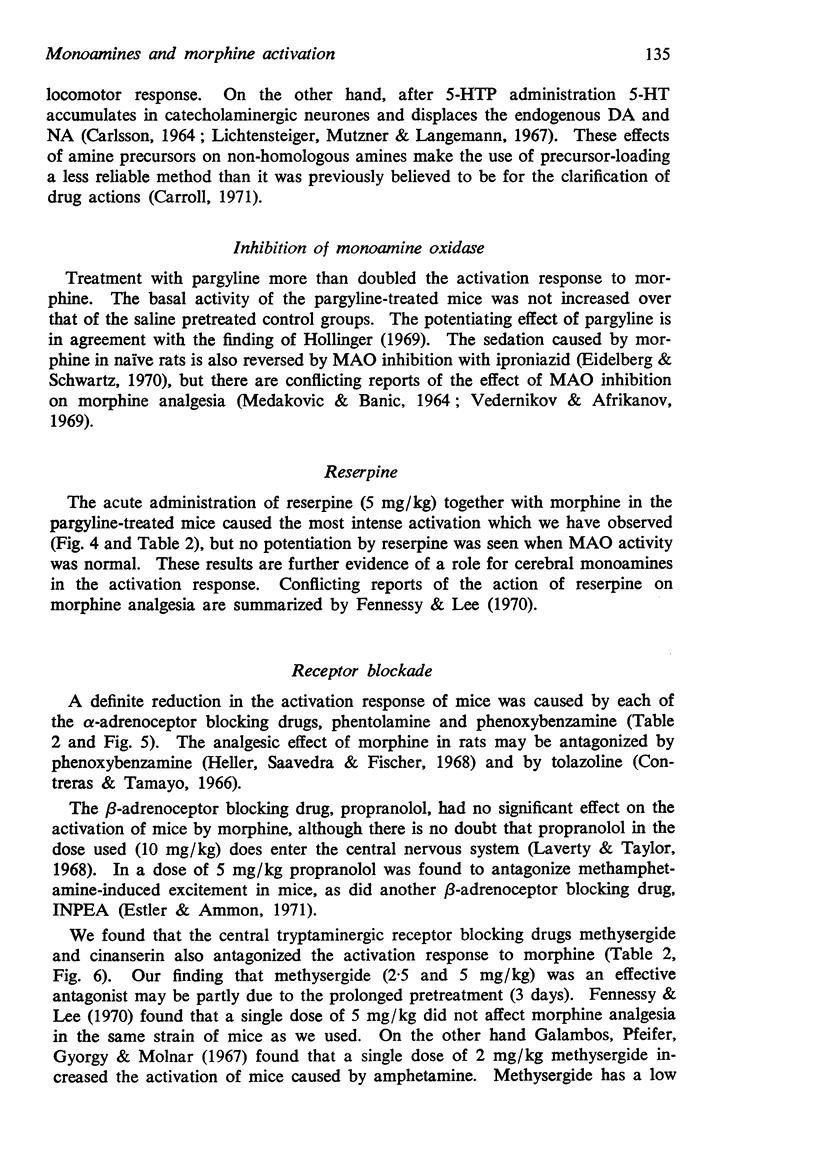
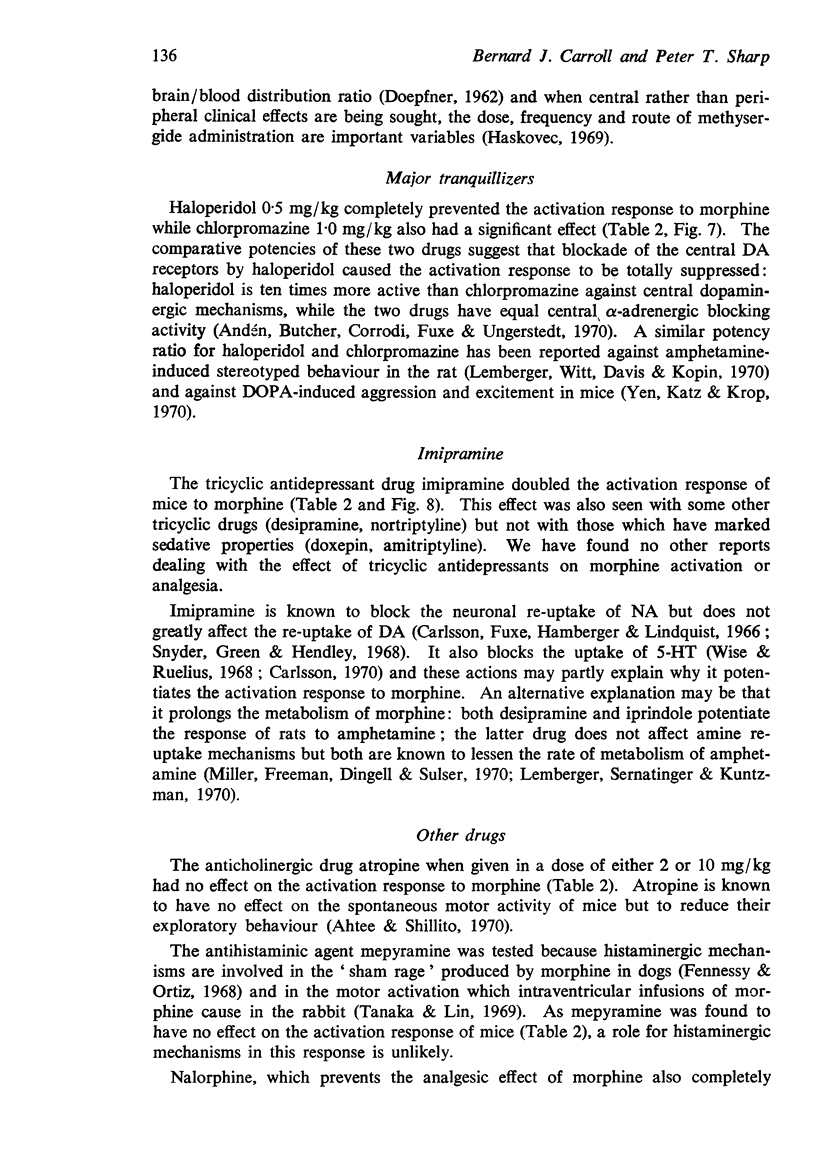
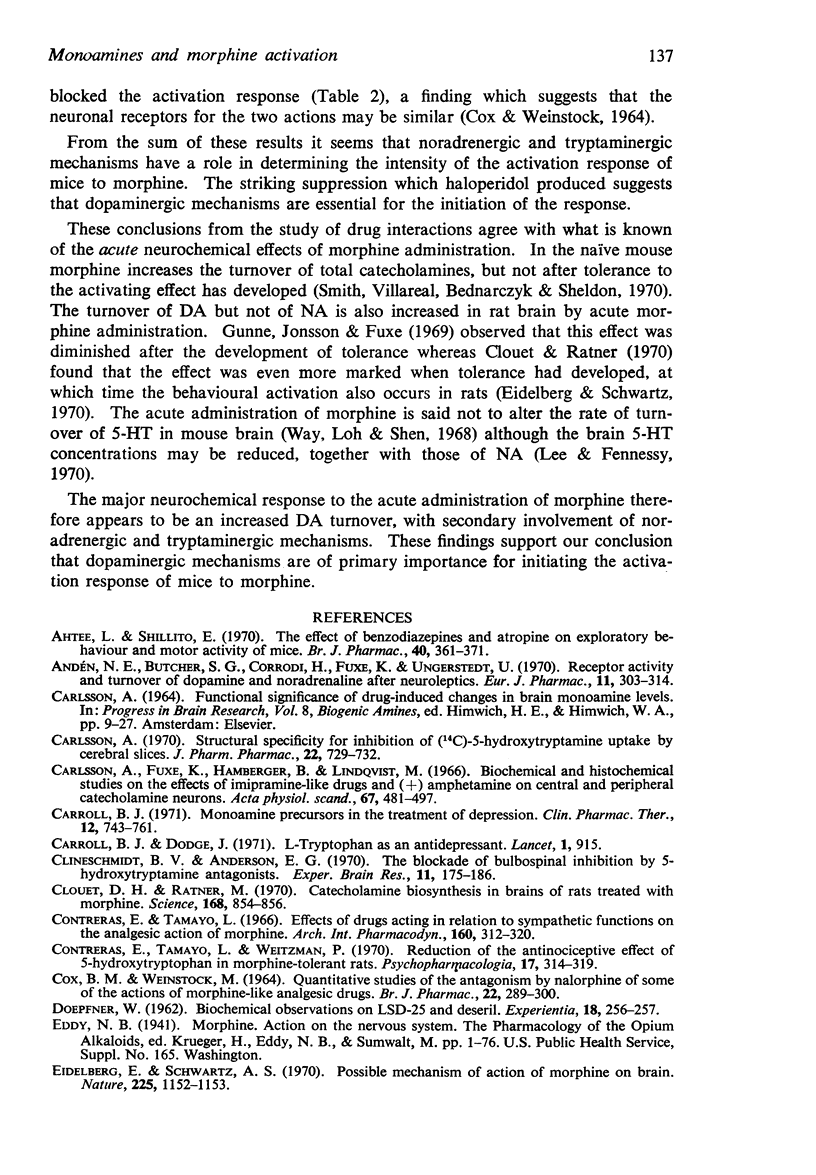

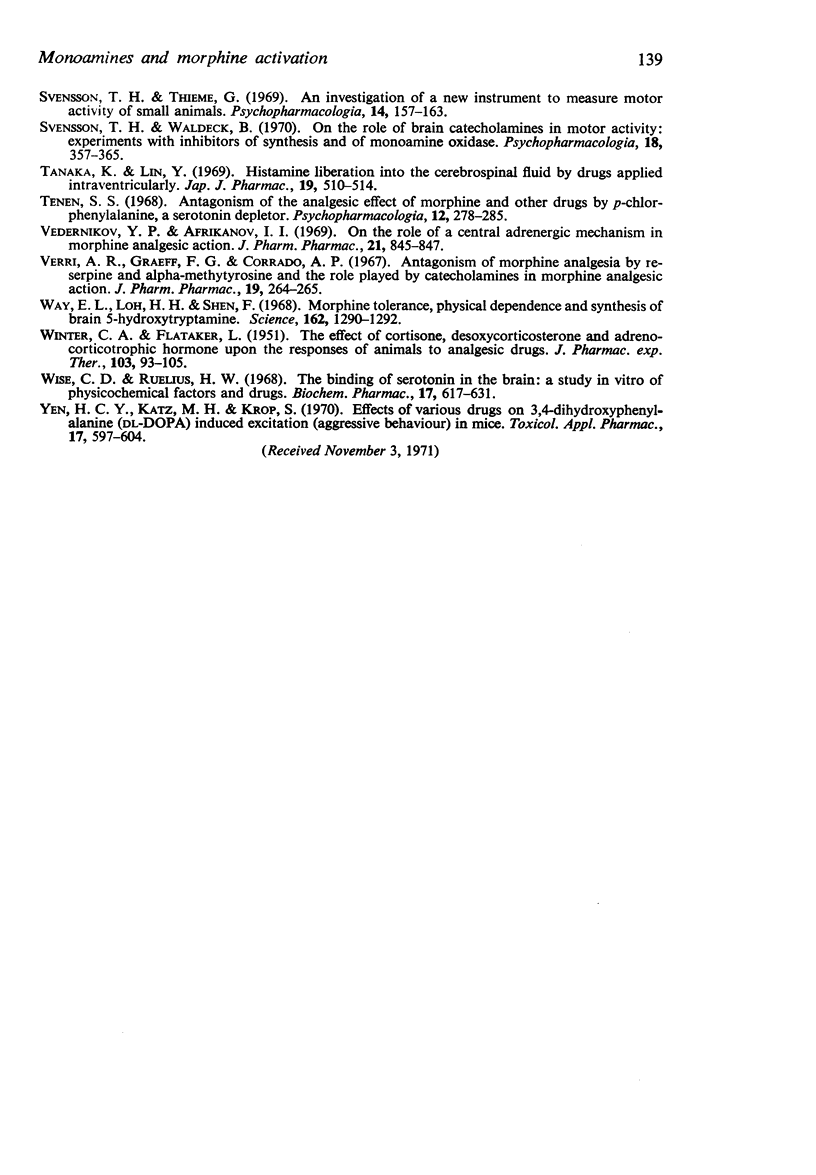
Selected References
These references are in PubMed. This may not be the complete list of references from this article.
- Ahtee L., Shillito E. The effect of benzodiazepines and atropine on exploratory behaviour and motor activity of mice. Br J Pharmacol. 1970 Oct;40(2):361–371. doi: 10.1111/j.1476-5381.1970.tb09928.x. [DOI] [PMC free article] [PubMed] [Google Scholar]
- Andén N. E., Butcher S. G., Corrodi H., Fuxe K., Ungerstedt U. Receptor activity and turnover of dopamine and noradrenaline after neuroleptics. Eur J Pharmacol. 1970;11(3):303–314. doi: 10.1016/0014-2999(70)90006-3. [DOI] [PubMed] [Google Scholar]
- COX B. M., WEINSTOCK M. QUANTITATIVE STUDIES OF THE ANTAGONISM BY NALORPHINE OF SOME OF THE ACTIONS OF MORPHINE-LIKE ANALGESIC DRUGS. Br J Pharmacol Chemother. 1964 Apr;22:289–300. doi: 10.1111/j.1476-5381.1964.tb02034.x. [DOI] [PMC free article] [PubMed] [Google Scholar]
- Carlsson A., Fuxe K., Hamberger B., Lindqvist M. Biochemical and histochemical studies on the effects of imipramine-like drugs and (+)-amphetamine on central and peripheral catecholamine neurons. Acta Physiol Scand. 1966 Jul-Aug;67(3):481–497. doi: 10.1111/j.1748-1716.1966.tb03334.x. [DOI] [PubMed] [Google Scholar]
- Carlsson A. Structural specificity for inhibition of [14C]-5-hydroxytryptamine uptake by cerebral slices. J Pharm Pharmacol. 1970 Oct;22(10):729–732. doi: 10.1111/j.2042-7158.1970.tb08419.x. [DOI] [PubMed] [Google Scholar]
- Carroll B. J., Dodge J. L-tryptophan as an antidepressant. Lancet. 1971 May 1;1(7705):915–915. doi: 10.1016/s0140-6736(71)92481-0. [DOI] [PubMed] [Google Scholar]
- Carroll B. J. Monoamine precursors in the treatment of depression. Clin Pharmacol Ther. 1971 Sep-Oct;12(5):743–761. doi: 10.1002/cpt1971125743. [DOI] [PubMed] [Google Scholar]
- Clineschmidt B. V., Anderson E. G. The blockade of bulbospinal inhibition by 5-hydroxytryptamine antagonists. Exp Brain Res. 1970;11(2):175–186. doi: 10.1007/BF00234321. [DOI] [PubMed] [Google Scholar]
- Clouet D. H., Ratner M. Catecholamine biosynthesis in brains of rats treated with morphine. Science. 1970 May 15;168(3933):854–856. doi: 10.1126/science.168.3933.854. [DOI] [PubMed] [Google Scholar]
- Contreras E., Tamayo L. Effects of drugs acting in relation to sympathetic functions on the analgesic action of morphine. Arch Int Pharmacodyn Ther. 1966 Apr;160(2):312–320. [PubMed] [Google Scholar]
- Contreras E., Tamayo L., Weitzman P. Reduction of the antinociceptive effect of 5-hydroxytryptophan in morphine tolerant rats. Psychopharmacologia. 1970;17(4):314–319. doi: 10.1007/BF00404236. [DOI] [PubMed] [Google Scholar]
- DOEPFNER W. Biochemical observations on LSD-25 and Deseril. Experientia. 1962 Jun 15;18:256–257. doi: 10.1007/BF02148217. [DOI] [PubMed] [Google Scholar]
- Eidelberg E., Schwartz A. S. Possible mechanism of action of morphine on brain. Nature. 1970 Mar 21;225(5238):1152–1153. doi: 10.1038/2251152a0. [DOI] [PubMed] [Google Scholar]
- Estler C. J., Ammon H. P. Modification by two beta-adrenergic blocking drugs of the effects of methamphetamine on behaviour and brain metabolism of mice. J Neurochem. 1971 May;18(5):777–779. doi: 10.1111/j.1471-4159.1971.tb12007.x. [DOI] [PubMed] [Google Scholar]
- Fennessy M. R., Lee J. R. Modification of morphine analgesia by drugs affecting adrenergic and tryptaminergic mechanisms. J Pharm Pharmacol. 1970 Dec;22(12):930–935. doi: 10.1111/j.2042-7158.1970.tb08475.x. [DOI] [PubMed] [Google Scholar]
- Fennessy M. R., Ortiz A. The behavioural and cardiovascular actions of intravenously administered morphine in the conscious dog. Eur J Pharmacol. 1968 Jun;3(3):177–185. doi: 10.1016/0014-2999(68)90129-5. [DOI] [PubMed] [Google Scholar]
- GREEN H., GREENBERG S. M., ERICKSON R. W., SAWYER J. L., ELLISON T. Effect of dietary phenylalanine and tryptophan upon rat brain amine levels. J Pharmacol Exp Ther. 1962 May;136:174–178. [PubMed] [Google Scholar]
- Galambos E., Pfeifer A. K., György L., Molnár J. Study on the excitation induced by amphetamine, cocaine and alpha-methyltryptamine. Psychopharmacologia. 1967;11(2):122–129. doi: 10.1007/BF00401248. [DOI] [PubMed] [Google Scholar]
- Goldstein A., Sheehan P. Tolerance to opioid narcotics. I. Tolerance to the "running fit" caused by levorphanol in the mouse. J Pharmacol Exp Ther. 1969 Oct;169(2):175–184. [PubMed] [Google Scholar]
- Gunne L. M., Jonsson J., Fuxe K. Effects of morphine intoxication on brain catecholamine neurons. Eur J Pharmacol. 1969 Mar;5(4):338–342. doi: 10.1016/0014-2999(69)90110-1. [DOI] [PubMed] [Google Scholar]
- Haskovec L. Methysergide in mania. Lancet. 1969 Oct 25;2(7626):902–902. doi: 10.1016/s0140-6736(69)92354-x. [DOI] [PubMed] [Google Scholar]
- Heller B., Saavedra J. M., Fischer E. Influence of adrenergic blocking agents upon morphine and catecholamine analgesic effect. Experientia. 1968 Aug 15;24(8):804–805. doi: 10.1007/BF02144880. [DOI] [PubMed] [Google Scholar]
- Hollinger M. Effect of reserpine, alpha-methyl-p-tyrosine, p-chlorophenylalanine and pargyline on levorphanol-induced running activity in mice. Arch Int Pharmacodyn Ther. 1969 Jun;179(2):419–424. [PubMed] [Google Scholar]
- Laverty R., Taylor K. M. Propranolol uptake into the central nervous system and the effect on rat behaviour and amine metabolism. J Pharm Pharmacol. 1968 Aug;20(8):605–609. doi: 10.1111/j.2042-7158.1968.tb09821.x. [DOI] [PubMed] [Google Scholar]
- Lee J. R., Fennessy M. R. The relationship between morphine analgesia and the levels of biogenic amines in the mouse brain. Eur J Pharmacol. 1970 Sep 1;12(1):65–70. doi: 10.1016/0014-2999(70)90029-4. [DOI] [PubMed] [Google Scholar]
- Lemberger L., Sernatinger E., Kuntzman R. Effect of desmethylimipramine, iprindole and DL-erythro-alpha-(3,4-dichlorophenyl)-beta-(t-butyl amino) propanol HC1 on the metabolism of amphetamine. Biochem Pharmacol. 1970 Dec;19(12):3021–3028. doi: 10.1016/0006-2952(70)90088-2. [DOI] [PubMed] [Google Scholar]
- Lemberger L., Witt E. D., Davis J. M., Kopin I. J. The effects of haloperidol and chlorpromazine on amphetamine metabolism and amphetamine stereotype behavior in the rat. J Pharmacol Exp Ther. 1970 Sep;174(3):428–433. [PubMed] [Google Scholar]
- Lichtensteiger W., Mutzner U., Langemann H. Uptake of 5-hydroxytryptamine and 5-hydroxytryptophan by neurons of the central nervous system normally containing catecholamines. J Neurochem. 1967 May;14(5):489–497. doi: 10.1111/j.1471-4159.1967.tb09548.x. [DOI] [PubMed] [Google Scholar]
- MEDAKOVIC M., BANIC B. THE ACTION OF RESERPINE AND ALPHA-METHYL-M-TYROSINE ON THE ANALGESIC EFFECT OF MORPHINE IN RATS AND MICE. J Pharm Pharmacol. 1964 Mar;16:198–206. doi: 10.1111/j.2042-7158.1964.tb07443.x. [DOI] [PubMed] [Google Scholar]
- Menon M. K., Dandiya P. C., Bapna J. S. Modification of the effect of some central stimulants in mice pretreated with alpha-methyl-1-tyrosine. Psychopharmacologia. 1967;10(5):437–444. doi: 10.1007/BF00403985. [DOI] [PubMed] [Google Scholar]
- Miller F. P., Cox R. H., Jr, Snodgrass W. R., Maickel R. P. Comparative effects of p-chloroamphetamine and p-chloro-N-methylamphetamine on rat brain norepinephrine, serotonin and 5-hydroxyindole-3-acetic acid. Biochem Pharmacol. 1970 Feb;19(2):435–442. doi: 10.1016/0006-2952(70)90199-1. [DOI] [PubMed] [Google Scholar]
- Miller K. W., Freeman J. J., Dingell J. V., Sulser F. On the mechanism of amphetamine potentiation by iprindole. Experientia. 1970 Aug 15;26(8):863–864. doi: 10.1007/BF02114225. [DOI] [PubMed] [Google Scholar]
- Pfeifer A. K., Galambos E. Toxicity and the action of reserpine on brain monoamines after pretreatment with monoamine oxidase inhibitors in isolated and aggregated mice. Psychopharmacologia. 1967;11(2):130–135. doi: 10.1007/BF00401249. [DOI] [PubMed] [Google Scholar]
- SHUSTER L., HANNAM R. V., BOYLE W. E., Jr A simple method for producing tolerance to dihydromorphinone in mice. J Pharmacol Exp Ther. 1963 May;140:149–154. [PubMed] [Google Scholar]
- SOURKES T. L., MURPHY G. F., CHAVEZ B., ZIELINSKA M. The action of some alpha-methyl and other amino acids on cerebral catecholamines. J Neurochem. 1961 Nov;8:109–115. doi: 10.1111/j.1471-4159.1961.tb13532.x. [DOI] [PubMed] [Google Scholar]
- SPECTOR S., SJOERDSMA A., UDENFRIEND S. BLOCKADE OF ENDOGENOUS NOREPINEPHRINE SYNTHESIS BY ALPHA-METHYL-TYROSINE, AN INHIBITOR OF TYROSINE HYDROXYLASE. J Pharmacol Exp Ther. 1965 Jan;147:86–95. [PubMed] [Google Scholar]
- Smith C. B., Villarreal J. E., Bednarczyk J. H., Sheldon M. I. Tolerance to morphine-induced increases in [14C]catecholamine synthesis in mouse brain. Science. 1970 Dec 4;170(3962):1106–1108. doi: 10.1126/science.170.3962.1106. [DOI] [PubMed] [Google Scholar]
- Snyder S. H., Green A. I., Hendley E. D. Kinetics of H3-norepinephrine accumulation into slices from different regions of the rat brain. J Pharmacol Exp Ther. 1968 Nov;164(1):90–102. [PubMed] [Google Scholar]
- Strömberg U. DOPA effects on motility in mice; potentiation by MK 485 and dexchlorpheniramine. Psychopharmacologia. 1970 Aug 19;18(1):58–67. doi: 10.1007/BF00402384. [DOI] [PubMed] [Google Scholar]
- Svensson T. H., Strömberg U. Potentiation by amantadine hydrochloride of L-dopa-induced effects in mice. J Pharm Pharmacol. 1970 Aug;22(8):639–640. doi: 10.1111/j.2042-7158.1970.tb10592.x. [DOI] [PubMed] [Google Scholar]
- Svensson T. H. The effect of inhibition of catecholamine synthesis on dexamphetamine induced central stimulation. Eur J Pharmacol. 1970 Oct;12(2):161–166. doi: 10.1016/0014-2999(70)90061-0. [DOI] [PubMed] [Google Scholar]
- Svensson T. H., Thieme G. An investigation of a new instrument to measure motor activity of small animals. Psychopharmacologia. 1969;14(2):157–163. doi: 10.1007/BF00403689. [DOI] [PubMed] [Google Scholar]
- Svensson T. H., Waldeck B. On the role of brain catecholamines in motor activity: experiments with inhibitors of synthesis and of monoamine oxidase. Psychopharmacologia. 1970;18(4):357–365. doi: 10.1007/BF00402762. [DOI] [PubMed] [Google Scholar]
- Tanaka K., Lin Y. Histamine liberation into the cerebrospinal fluid by the drugs applied intraventricularly. Jpn J Pharmacol. 1969 Dec;19(4):510–514. doi: 10.1254/jjp.19.510. [DOI] [PubMed] [Google Scholar]
- Tenen S. S. Antagonism of the analgesic effect of morphine and other drugs by p-chlorophenylalanine, a serotonin depletor. Psychopharmacologia. 1968;12(4):278–285. doi: 10.1007/BF00401407. [DOI] [PubMed] [Google Scholar]
- Vedernikov Y. P., Afrikanov I. I. On the role of a central adrenergic mechanism in morphine analgesic action. J Pharm Pharmacol. 1969 Dec;21(12):845–847. doi: 10.1111/j.2042-7158.1969.tb08183.x. [DOI] [PubMed] [Google Scholar]
- Verri R. A., Graeff F. G., Corrado A. P. Antagonism of morphine analgesia by reserpine and alpha-methyltyrosine and the role played by catecholamines in morphine analgesic action. J Pharm Pharmacol. 1967 Apr;19(4):264–265. doi: 10.1111/j.2042-7158.1967.tb08083.x. [DOI] [PubMed] [Google Scholar]
- WINTER C. A., FLATAKER L. The effect of cortisone, desoxycorticosterone, and adrenocorticotrophic hormone upon the responses of animals to analgesic drugs. J Pharmacol Exp Ther. 1951 Sep;103(1):93–105. [PubMed] [Google Scholar]
- Way E. L., Loh H. H., Shen F. Morphine tolerance, physical dependence, and synthesis of brain 5-hydroxytryptamine. Science. 1968 Dec 13;162(3859):1290–1292. doi: 10.1126/science.162.3859.1290. [DOI] [PubMed] [Google Scholar]
- Wise C. D., Ruelius H. W. The binding of seotonin in brain: a study in vitro of the influence of physicochemical factors and drugs. Biochem Pharmacol. 1968 Apr;17(4):617–631. doi: 10.1016/0006-2952(68)90277-3. [DOI] [PubMed] [Google Scholar]
- Yen H. C., Katz M. H., Krop S. Effects of various drugs on 3,4-dihydroxyphenylalanine (DL-DOPA)-induced excitation (agressive behavior) in mice. Toxicol Appl Pharmacol. 1970 Nov;17(3):597–604. doi: 10.1016/0041-008x(70)90034-7. [DOI] [PubMed] [Google Scholar]


